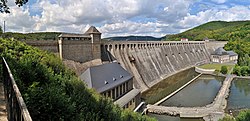You can help expand this article with text translated from the corresponding article in German. (February 2025)Click [show] for important translation instructions.
|
| Edersee Dam | |
|---|---|
 | |
| Country | Germany |
| Location | Waldeck-Frankenberg, Hesse |
| Coordinates | 51°11′00″N09°03′32″E / 51.18333°N 9.05889°E |
| Construction began | 1908 |
| Opening date | 1914 |
| Dam and spillways | |
| Type of dam | Gravity dam |
| Impounds | Eder |
| Height | 48 m (157 ft) |
| Length | 400 m (1,312 ft) |
| Width (crest) | 6 m (20 ft) |
| Width (base) | 36 m (118 ft) |
| Dam volume | 300,000 m3 (10,594,400 cu ft) |
| Spillway capacity | 1,774 m3/s (62,648.2 cu ft/s) |
| Reservoir | |
| Creates | Edersee |
| Total capacity | 199,300,000 m3 (7.038213078×109 cu ft) |
| Catchment area | 1,443 km2 (557 sq mi) |
| Surface area | 11.8 km2 (4.6 sq mi) |
| Maximum water depth | 41.7 m (137 ft) |
| Power Station | |
| Operator | 16.9 m |
| Type | Conventional |
| Hydraulic head | 45 m (148 ft) |
| Installed capacity | 21MW |
The Edersee Dam is a hydroelectric dam spanning the Eder river in northern Hesse, Germany. Constructed between 1908 and 1914, it lies near the small town of Waldeck at the northern edge of the Kellerwald. Breached by Allied bombs during World War II, it was rebuilt during the war, and today generates hydroelectric power and regulates water levels for shipping on the Weser river.
Contents
At low water in late summers of dry years the remnants of three villages (Asel, Bringhausen, and Berich) and a bridge across the original river bed submerged when the lake was filled in 1914 can be seen. Descendants of those buried there go to visit the graves of their ancestors.
- Overflowing Edersee Dam in spring 2021
- The Edersee today (low water level)



